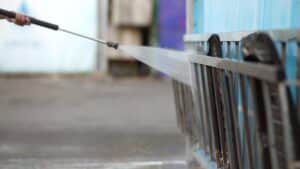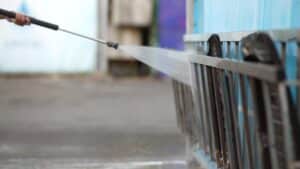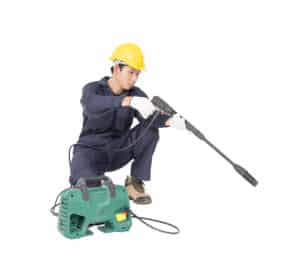Are there any safety precautions specific to using a gas pressure washer?
Key Takeaways
- Avoid using a gas pressure washer in enclosed spaces
- Wear appropriate protective gear
- Read the user manual thoroughly
When it comes to using a gas pressure washer, there are indeed several safety precautions that need to be taken into consideration. While pressure washers can be incredibly useful for a variety of cleaning tasks, they can also pose certain risks if not used properly. In this article, we will explore the specific safety precautions that should be followed when using a gas pressure washer.
Avoid using a gas pressure washer in enclosed spaces
One of the most important safety precautions when it comes to gas pressure washers is to avoid using them in enclosed spaces. Gas pressure washers emit carbon monoxide, a colorless and odorless gas that can be extremely dangerous if inhaled in high concentrations. To prevent carbon monoxide poisoning, it is crucial to only operate gas pressure washers in well-ventilated outdoor areas.
Wear appropriate protective gear
Another essential safety measure is to wear the appropriate protective gear when operating a gas pressure washer. This includes safety glasses or goggles to protect your eyes from debris or splashing chemicals, enclosed shoes to shield your feet from potential hazards, gloves to protect your hands, and long pants to prevent any potential injuries to your legs. Additionally, it is recommended to wear hearing protection to reduce the risk of hearing damage due to the loud noise produced by the pressure washer.
Read the user manual thoroughly
Prior to operating a gas pressure washer, it is crucial to read the user manual thoroughly. Each pressure washer model may have specific instructions and safety guidelines that need to be followed. By familiarizing yourself with the user manual, you will have a better understanding of how to operate the pressure washer safely and efficiently.
Be aware of your surroundings
When using a gas pressure washer, it is important to be aware of your surroundings. This includes being mindful of the presence of children, pets, passing cars, slippery surfaces, and electrical wires or power lines. Taking the time to assess your surroundings and ensure a clear and safe workspace can help prevent accidents and injuries.
Start washing with the widest angle spray tip
When beginning a pressure washing task, it is recommended to start with the widest angle spray tip. This provides a wider spray pattern and reduces the risk of high-pressure injection injuries. As you progress with the cleaning, you can gradually adjust the nozzle and distance as needed.
Avoid working at height
Working at height while operating a gas pressure washer can be dangerous, as the force of the spray can cause instability and increase the risk of falls. It is advisable to avoid using ladders and instead use an extension wand to reach higher areas. This allows you to keep your feet firmly on the ground and maintain better balance.
Conduct a pre-job analysis
Prior to starting any pressure washing task, it is recommended to conduct a pre-job analysis. This involves assessing the workplace, identifying potential hazards, and implementing necessary controls to prevent accidents and injuries. By taking the time to analyze the work area, you can proactively address any safety concerns and minimize risks.
In conclusion, using a gas pressure washer requires specific safety precautions to ensure the well-being of the operator and those in the surrounding area. These precautions include avoiding the use of gas pressure washers in enclosed spaces, wearing appropriate protective gear, thoroughly reading the user manual, being aware of your surroundings, starting with the widest angle spray tip, avoiding working at height, and conducting a pre-job analysis. By following these safety guidelines, you can enjoy the benefits of a gas pressure washer while minimizing the risk of accidents or injuries.
Related Websites:
FAQs:
Q: Are gas pressure washers more effective than electric models?
Yes, gas pressure washers are generally more powerful than electric models. They provide higher water pressure and flow rates, making them ideal for tackling tough cleaning tasks such as removing deep-seated grime, mold, and mildew.
Q: What safety precautions should I take when using a gas pressure washer?
When using a gas pressure washer, it is important to follow these safety precautions:
1. Read the manufacturer’s instructions carefully and follow them.
2. Wear safety goggles, gloves, and closed-toe shoes to protect yourself.
3. Be cautious of slippery surfaces and bystanders while operating the pressure washer.
4. Use the equipment in a well-ventilated area to prevent carbon monoxide poisoning.
5. Handle fuel with caution, store it in approved containers, and avoid ignition sources.
6. Regularly inspect and maintain the pressure washer’s engine.
7. Never point the spray gun at yourself, others, or electrical outlets.
8. Properly store and transport the pressure washer, draining fuel and relieving pressure before storage.
Q: Can I use a gas pressure washer indoors?
No, it is not safe to use a gas pressure washer indoors or in enclosed spaces. Gas pressure washers emit carbon monoxide, which is a toxic gas that can be harmful or fatal if inhaled in high concentrations. Always use the equipment in a well-ventilated area, preferably outdoors.
Q: What should I do to ensure the safe storage and transport of a gas pressure washer?
To ensure safe storage and transport of a gas pressure washer:
1. Drain the fuel and remove any residual pressure before storing the equipment.
2. Secure the pressure washer during transport to prevent damage or accidents.
3. Store the pressure washer in a cool, dry place away from ignition sources.
4. Follow the manufacturer’s instructions for any additional storage requirements.
Q: How can I prevent accidents while using a gas pressure washer?
To prevent accidents while using a gas pressure washer:
1. Always start with the lowest pressure setting and gradually increase it if needed.
2. Never point the spray gun at yourself, others, or electrical outlets.
3. Use the appropriate nozzles and attachments for your specific cleaning tasks.
4. Be cautious of slippery surfaces and maintain a safe distance from bystanders.
5. Prioritize your safety and the safety of others by following the manufacturer’s instructions and exercising caution at all times.






